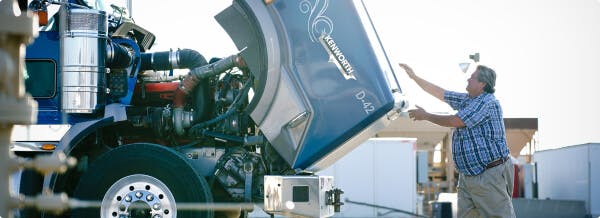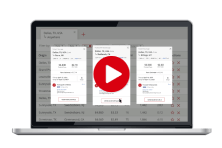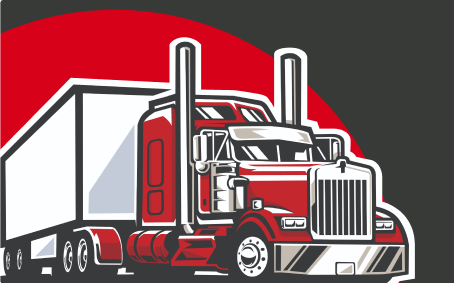
The Trucker’s Guide to Succeed in 2024
How to Survive in Any Economy
 In times of economic fluctuations, it’s crucial to make smart business decisions for survival. Whether you’re an independent owner-operator with one or two trucks or a carrier with a fleet, you need to know how to protect your profits. This means being able to calculate how much money you aim to make after you account for your cost-per-mile and your monthly expenses – at all times.
While numbers will vary widely from person to person, profitability is the goal across the board. Implementing cost-cutting measures and operational efficiencies are key to building and maintaining a successful business that can weather any market cycle.
In times of economic fluctuations, it’s crucial to make smart business decisions for survival. Whether you’re an independent owner-operator with one or two trucks or a carrier with a fleet, you need to know how to protect your profits. This means being able to calculate how much money you aim to make after you account for your cost-per-mile and your monthly expenses – at all times.
While numbers will vary widely from person to person, profitability is the goal across the board. Implementing cost-cutting measures and operational efficiencies are key to building and maintaining a successful business that can weather any market cycle.
This trucker’s guide focuses on four major areas where you can gain efficiencies that directly affect your bottom line.

1. Take control of your fuel consumption.
While fuel costs are considered “fixed,” meaning they can’t be controlled, there are some actions you can take to minimize your fuel consumption.
And when they’re all performed in conjunction, the savings can help you squeeze out any additional profit margins.
Here are the top ways to lower your fuel consumption
- Consider your tires’ rolling resistance. Rolling resistance refers to the energy it takes your tires to rotate, affected by the friction caused when the tire surface meets the road. The Department of Energy estimates that 4 to 11 percent of fuel consumption is due to tire rolling resistance. Industry studies show that a 10 percent drop in rolling resistance equates to about a one percent improvement in fuel economy. It might not seem like a big difference, but fuel economy gains are difficult to come by, and every little bit adds up.
Grab that advantage by making an informed tire purchase. Tire technology advances have made it so you no longer have to choose between excellent grip, long tread life, or rolling resistance. Look beyond the purchase price to consider the long-term costs. Some of the priciest tires deliver both excellent traction and long life, making their true cost of ownership among the lowest, especially when you consider the fuel savings.
- Don’t speed. Your fuel mileage decreases once your truck passes its optimal speed, which is around 60 mph. This means that every time you exceed this speed, you’re wasting fuel (and money). Even a slight decrease in your highway driving speed can significantly reduce your fuel consumption, and only adds a few minutes to your travel time.
According to the Department of Energy, every five miles per hour (MPH) you drive above 60 MPH is like paying an additional 24 cents per gallon for fuel. That’s because at higher speeds, your truck encounters more wind resistance and your tires encounter more rolling resistance.
- Find your engine’s “sweet spot.” The “sweet spot” is the most efficient revolutions per minute (RPM) to run your engine. If your engine is working harder to drive at a certain speed, you will burn more fuel. The trick is to use torque, not horsepower, to pull your load. Pulling with torque means you’re sustaining your speed without overworking the engine. A good sweet spot is around 1250 – 1350 RPM. Every truck engine varies, so check your owner’s manual or your truck dealer to understand your peak horsepower and torque at a specific RPM. Just remember, the lower the RPM, the less fuel your engine will consume.
- Get a proper fuel card. Large carriers with big fleets negotiate fuel cards that earn them points and discounts based on purchase volumes, delivering savings as much as a dollar off per gallon. Independent owner-operators can also negotiate for fuel savings. Discounts may be a flat percentage of the total purchase, or monthly rebates. Generally, owner-operators can expect to pay the cash price or less when using a fuel card and can save up to 30 cents a gallon with the help of a fuel card.
A fuel card can also help you streamline your accounting, preventing you from losing valuable receipts or missing expenses. Many fuel cards will link right to your accounting software or cloud-based fuel management platforms, simplifying the process and eliminating the need to keep your receipts or manually record your fuel purchases.
Truckstop can help you find a fuel card that works for your business. Truckstop Load Board subscribers can access our Partner Marketplace to find fuel card providers and other industry resources.
- Plan your routes. Once you book a load, don’t just hit the road with no return plan. Make the most of every mile by working to eliminate deadheads and driving empty miles.
Route planning also helps you avoid the temptation of speeding to meet a delivery deadline. For instance, if you’re facing an 8-hour haul and you only have 9 hours to get there, you might be tempted to up your speed, raising your fuel costs. If you plan your routes in advance, you’ll avoid these types of tight time constraints that wreak havoc on your wallet (and cause unnecessary stress).
Also, consider the number of off- and on-ramps. Your truck burns more fuel on an on-ramp as it works to get up to speed. Avoiding them to get to a fuel stop improves your fuel mileage.
- Understand the fuel surcharge index. Fuel surcharges can make a huge difference in your overall operating expenses. Negotiating your rates by understanding the fuel surcharge index ensures your rates and contract negotiations are fair and profitable. For example, if you see a rate that looks good but doesn’t account for the current fuel surcharge, you might be leaving money on the table. Even negotiating five more cents can move the needle and help you determine if you’re making enough money on a load.
Consider these questions prior to negotiating your rates:
- What is an accurate baseline fuel price? Fuel surcharges only kick in after the baseline fuel price is reached. The baseline fuel price you set in your contract is often based on the current price of fuel, but you can also select a standard base fuel price that will be more flexible over time.
- Have you implemented fuel surcharge caps and floors? A fuel surcharge cap is the maximum surcharge that a carrier can charge a shipper. Even if the surcharge cap is met, the carrier cannot charge the shipper more—regardless of whether the cap price reflects the actual cost of fuel. Carriers that implement a cap can risk losing money in the event that fuel prices skyrocket.
Conversely, a surcharge floor is the minimum surcharge that a carrier can charge a shipper. In the case that fuel prices dip below the floor, the shipper will still be required to pay the agreed upon amount. - Should you negotiate a fixed or variable fuel surcharge? Decide if a fixed fuel surcharge or a variable fuel surcharge best fits your business.
A fixed surcharge is a set amount that does not change based on changes in fuel prices. This is advantageous when fuel prices are expected to remain stable for an extended period of time.
Variable fuel surcharges rise and fall along with fuel prices. Implementing a variable surcharge structure during periods of fuel price volatility lets you avoid the risk of having to cover the costs of dramatic fuel price changes.
- What is the lane data? Proper route planning includes knowing the data for the lanes you’ll be driving. Determine if the rate is competitive for each particular load for that specific lane. This will help you negotiate the best rates.
Truckstop Load Board Pro Rate Insights delivers the data you need to negotiate a rate that covers all your costs and pay yourself a decent wage.

2. Stay on top of truck maintenance.
The thing about unexpected expenses is they’re unexpected! But know this: They will happen. In fact, the number one reason carriers go out of business is major mechanical failure without a safety net in place. That’s why you must have a preventative maintenance plan (plus a rainy-day savings fund) to minimize repairs. Keeping your equipment in tip-top working order will help prevent major breakdowns, but accidents happen, and failures occur regardless of how diligent you are with a maintenance schedule. A new transmission can cost up to $10k! Be prepared!
Here are the best ways to lower maintenance costs and get more miles out of your truck:
- Make a maintenance plan and follow it. Preventative maintenance should include regular daily pre- and post-trip inspections; fixing defects as soon as you’re aware of them; and a scheduled program that routinely checks airlines, hoses, brakes, wiring, and alternators. A service schedule can help you stay on track when it comes to common maintenance checkpoints. However, you should still consult manufacturer recommendations as they can vary.
A good preventative practice is to adjust your maintenance plan depending on the season. Extreme hot and cold weather conditions require different approaches, so make sure your plan accommodates seasonal needs. In warmer temps, pay particular attention to air conditioning, coolant, your electrical system, and tire pressure. In cold conditions, extra care should be given to your windshield and wipers, your braking system, fluids, and tire tread.
Some maintenance can be DIY to save money, but make sure to consult an expert for complicated issues that need the attention of a professional. The goal is to get your truck back on the road as quickly as possible. But it’s better to do it right the first time to avoid roadside breakdowns.
Maintenance Items |
Normal-Heavy Duty |
Severe Duty |
| Classic Lube | 15,000 miles | 15,000 miles |
| Battery Service | 6 Months | 6 Months |
| 3-axle Alignment | Every 12 months | Every 12 months |
| Oil Change/B service | 4,500 miles or 1,300 hours | 35,000 miles or 825 hours |
| Air Filter Fuel Tank Vent | 12 months | 6 months |
| Power Steering Fluid Filter | 150,000 miles | 150,000 miles |
| Battery Service | 6 months | 6 months |
| Valve adjustment | 150,000 miles then every 300,000 miles after the first overhead (valve adjustment) | 150,000 miles then every 200,000 miles after the first overhead (valve adjustment) |
| DEF System Service | 150,000 miles | 150,000 miles |
| AHI Clean/Replace | 150,000 miles | 100,000 miles |
| DPF Filter Clean/Brake | 400,000 miles | 250,000 miles |
| Coolant Filter Replace | 300,000 miles | 150,000 miles |
| Coolant Replace/Flush | 750,000 miles | 750,000 miles |
| Transmission Filter/Fluid Replace | 500,000 mi or 60 months | 500,000 mi or 60 months |
| Fan/Accessory Drive Belt Replace | 300,000 miles | 150,000 miles |
| Differential Oil Replace | 250,000 miles | 150,000 miles |

- Save money for maintenance and repairs. This might be easier said than done, especially when margins are already tight, but you can’t make money if your truck is inoperable. Even small savings help offset costs. Try to build up a savings fund that can handle a worst-case hit. Depending on the age and condition of your truck, the chart below gives a good guideline of what you should be saving.
Truck Age/Mileage |
Savings Per Mile |
| New | 5 cents |
| 1 year or 150k | 6 cents |
| 1 year or 150k | 6 cents |
| 2 years or 300k | 7 cents |
| 3 years or 450k | 8 cents |
| 4 years or 600k | 10 cents |
| 5+ years or 750k+ | 15 cents |
When it comes to your numbers, make sure you know what it takes to run your truck, including how much you need to set aside for maintenance, and negotiate that into your rates. It’s this type of planning and negotiating that separates the successful driver from the one who’s barely making it.
You should also be thinking about your truck’s “use cycle.” If your truck has a million miles on it, you’re likely looking at a host of mechanical failures that could take you off the road altogether. At some point, it makes more sense to consider buying a new or used truck that requires less repairs and that you can consistently rely on.

3. Maximize your time.
You’ve heard it at least once, probably more: In trucking, time is money. But it bears repeating. Whether you’re a new or seasoned owner-operator, you’re running a business. Effective time management can make or break you. The more time you spend on the road making money, the better. You will not be compensated for the necessary back-office tasks that still must be done, including creating invoices and billing brokers, looking for brokers to work with and fostering relationships, tax reporting, and FINDING LOADS, the very heart of your business.
Here’s how to make the most of your time:
- Find loads faster. Use a load board that serves up not just quantity, but quality loads. A sub-par load board might boast that they post “over a million loads every day,” but often they are rife with duplicate loads, old loads, and loads posted by imposter brokers. Use a load board that delivers quantity plus quality. Otherwise, you’ll waste valuable time chasing after loads that lead to nowhere. A quality load is one posted by a verified, vetted broker at a fair rate that aligns with industry data.

The Truckstop Load Board helps you find the right loads that match your requirements—quickly. You can compare loads side-by-side and make fast, yet informed, decisions.
You can also set up Load Alert Notifications so you’ll receive new load alerts based on your preferences, ensuring you never miss a potential load again. Learn how you can find your next load with Truckstop.
View features
- Find loads faster. Find the balance between booking high-paying loads and hauling more loads. Obviously, you always want to command the highest possible rate. The more loads available in each lane, the more negotiation power you have. But it’s also true that the more freight you haul, the better. The wisest carriers find the sweet spot. Sometimes you must forsake a great rate so you don’t exceed your hours of service (HOS). In such instances, a lower-paying load is better than no load at all, if you can cover your costs and still make money.
- Carefully consider your route planning. If you know how long you can be out on the road, whether it’s three days, two weeks, or 25 days, choose a string of several loads that will pay the most money for your time. Some of those loads might pay high rates, some might be a bit low, but look at the whole trip to find the combination that returns the profit you need for the time you’re out. Take the time to plan your route to maximize your time and earnings.
- Ditch the time-consuming paperwork. Paperwork is trucking’s dirty little secret no one talks about. Most owner-operators didn’t choose the gig because they love the tedious tasks of running an office. Still, it must be done. You need to get paid, so you need to invoice brokers. You need to file taxes, so you need to keep track of earnings and expenses. Invest in a Transportation Management System (TMS) that automates your business management tasks, freeing you up to process more loads and make more money.
Get paid faster with every load you haul by using Truckstop Factoring on the mobile app, Truckstop Go™. Learn how to lower the stress of billing and maximize your profits.
- Make friends with electronic logging devices (ELDs). Currently, carriers are paid by the mile. That means the time you spend sitting in traffic, waiting for a load, or being idle because of circumstances beyond your control, is time wasted—with zero pay. So, if you’re detained by a shipper or stuck at a loading dock for pick-up, you’re not being paid for your time, even though your job requires you to be there. ELDs will change all that for the better, automatically recording your time so you get paid for it. You can even use this downtime to find future loads fast. And that’s time well-spent.

4. Protect Yourself Against Fraud
Fraud continues to be heightened in the freight market. Scammers impersonate legit players to steal cargo or payments. Online scams aren’t the only threat – watch out for hijackings on the road too! These scams cost time, money, and your good name. In this tight market, get smart and stay safe from freight fraud and unnecessary financial losses. When every dollar matters, it’s important to protect yourself from any unnecessary losses.
Here are the 4 main types of fraud that specifically target freight carriers and independent owner-operators:
- Theft – Theft can occur when a fraudster infiltrates an online payment system and duplicates invoices then falsely submits them to collect/steal the money. Cargo theft can occur when a criminal poses as an authentic carrier and intercepts haulage instructions, falsifying cargo pick-up or delivery documentation to steal loads, or poses as a freight forwarder and gives a driver false instructions. They act as a middleman between a legitimate hauler and shipper, giving the driver new instructions and an alternative address where the cargo is then stolen. Cargo theft can also be blatant stealing of goods right off your truck.
- Phishing and smishing scams – Phishing scams are fraudulent emails or websites, mostly via business emails, whereas smishing scams are fraudulent text messages. Both trick people into giving their passwords or other confidential data. A scammer will impersonate an official source to gain sensitive personal security information with the intent to steal a carrier’s identity. Always be cautious when clicking on links in emails and texts and never give your password to anyone who requests it
- Factoring scams – Factoring has also become a major target for fraud. Scammers will send fraudulent advance pay notices, either inflating the numbers of a real invoice or requesting payment for a service they didn’t provide. Partnering with a reputable freight factoring company with tools in place to identify suspicious activity and stop bad actors can help keep you safe
- The DOT scam – In this scam, a fraudster poses as a DOT representative or an on-site police officer during a DOT inspection and contacts a trucking company demanding payment for a fictitious violation. Or, a scammer sends a letter to the trucking company requesting payment to renew their DOT. (USDOT numbers are filed and renewed for free on the FMCSA website).

Ways to help protect your business from fraud
- Thoroughly vet everyone you work with. Never do business with another carrier or broker without investigating them first to verify their identity and trustworthiness.
- Avoid re-using passwords and login numbers. Using the same password for all your accounts can expose you to security risks. Create unique passwords and logins and change them frequently
- Communicate. Don’t hesitate to ask questions, especially if you notice suspicious behavior. Verify details with all involved parties and dig deeper if the specifics of a particular load seem unusual or don’t quite add up. Keep friends and family notified of your whereabouts and check in regularly
- Take physical security measures. Pay attention to your surroundings to protect you and your freight. Park safely (in view of security cameras if they exist) and invest in a dash cam. And always use locks, security seals, and security devices if the cargo you’re in charge of is susceptible to theft. Report any suspicious activity to law enforcement.
- Alert the FBI to suspicious behavior. The misconception that authorities aren’t actively working to prevent and stop scammers often deters people from reporting freight fraud. But federal agents at the FBI take cargo theft very seriously and rely on verifiable information to track and disband Major Theft Organizations (MBO). Report suspicious behavior to help them track down criminals and increase awareness for this growing problem to avoid becoming a victim.
Check out Freight Nation: A Trucking Podcast.
Whether you’re a brand-new broker or seasoned pro, Freight Nation entertains, informs, and educates. Don’t miss out.
